Abstract
This paper is devoted to studying the statistical approximation properties of a sequence of univariate and bivariate blending-type Bernstein operators that includes shape parameters and and a positive integer. An estimate of the corresponding rates was obtained, and a Voronovskaja-type theorem is given by a weighted A-statistical convergence. A Korovkin-type theorem is provided for the univariate and bivariate cases of the blending-type operators. Moreover, the convergence behavior of the univariate and bivariate new blending basis and new blending operators are exhaustively demonstrated by computer graphics. The studied univariate and bivariate blending-type operators reduce to the well-known Bernstein operators in the literature for the special cases of shape parameters and and they propose better approximation results.
Keywords:
Voronovskaja-type theorem; blending-type operators; α-Bernstein operators; λ-Bernstein operators; shape parameters; statistical convergence; convergence rates; bivariate approximation; computer graphics MSC:
41A10; 41A25; 41A36; 26A16; 40C05
1. Introduction
The uniform approximation of continuous functions by polynomials was one of the problems that Karl Weierstrass focused on (see []). The classical Weierstrass approximation theorem asserts that there exists a sequence of polynomials that converges uniformly to for any continuous function on the closed interval . Later, Bernstein provided an alternative proof of the well-known Weierstrass approximation theorem currently called Bernstein polynomials (see []). The following Bernstein operators:
where,
were given in [] to approximate a given continuous function on
The Bernstein approximation technique has been used in both applied mathematics and functional analysis. For instance, an algorithm for the approximate solution of singularly perturbed Volterra integral equations and a numerical scheme for the computational solution of a new class of Volterra integral equations of the third kind via the Bernstein-type operators were proposed in [,].
Recently, Chen et al. constructed a new family of Bernstein operators for the continuous function on , which includes the shape parameter , and named it the -Bernstein operators []. They investigated certain elementary properties of these operators, such as end-point interpolation, linearity, and positivity, and obtained an upper bound for the error in terms of the usual modulus of continuity. Many variations of -Bernstein operators have been examined (see [,,]).
A new basis with shape parameter was introduced in [] to give a practical algorithm of curve modeling. The authors studied certain important properties of the basis function and the related curves, and extended their research to the tensor product surface with two shape parameters. A new type of -Bernstein operators was constructed by shape parameter in []. A Korovkin-type approximation theorem was provided; a local approximation theorem was investigated; a convergence theorem for the Lipschitz continuous functions was given; a Voronovskaja-type asymptotic formula was obtained as well.
Recently, shape parameters and were used to extend Bernstein operators to -Bernstein type (see [,,,,,,,,,,]) and -Bernstein type operators (see [,,,,,,,,]) in order to approximate functions better, respectively. The convergence of linear positive operators by the shape parameters and in the space of continuous functions of two variables was studied in [,,] and [,,], respectively. In [], certain estimates of the differences of -Bernstein and -Durrmeyer and -Bernstein and -Kantorovich operators were established.
This paper is focused on the statistical approximation properties of univariate and bivariate -Bernstein operators. The corresponding rates of convergence were estimated by the weighted A-statistical convergence. A Korovkin-type and a Voronovskaja-type theorem for the bivariate case were obtained by the weighted A-statistical convergence. A Korovkin-type theorem is provided for the bivariate case, and the convergence rate of blending bivariate operators to a function was computed by the modulus of continuity. Moreover, the convergence behavior of blending univariate and bivariate -Bernstein operators and the behavior of blending univariate and bivariate polynomials are demonstrated by computer graphics.
2. Preliminaries
In this section, we give the definitions of -Bernstein, -Bernstein, and blending -Bernstein basis functions. Furthermore, the definitions of -Bernstein, -Bernstein, and blending -Bernstein operators and all needed results are provided.
Let throughout the paper the binomial coefficients be given by the formula:
The original -Bernstein operators (see []) are defined as:
where , , and the -Bernstein basis is given as:
for , .
Furthermore, the -Bernstein operators are given as (see []):
where the -Bernstein basis is given as:
On the other hand, in [], the authors introduced generalized blending-type -Bernstein operators by implementing a positive integer s as:
and:
which depend on shape parameter where , .
Finally, blending-type -Bernstein operators were constructed in [] as follows:
where , and s is a positive integer, and the blending-type basis is given as:
and defined in Equation (2).
In [], the authors proposed an alternative representation for (3) as:
Lemma 1
([]Theorem2).If , for any and , we have the following identities:
3. Statistical Convergence of Univariate Blending -Bernstein Operators
In this section, certain statistical convergence results for blending operators are provided. First, the needed standard notions and notations that were also given in the papers [,] are provided.
Definition 1.
Let vertical bars denote the cardinality of the enclosed set, then the natural density of is represented by provided that the limit exists, where ,
Definition 2.
A sequence of numbers is called statistically convergent to a number E, denoted by st-limp , if, for each ,
The A-transform of u denoted by is defined as for a given non-negative infinite summability matrix . If whenever , we say that A is a regular method. Then, sequence is said to be A-statistically convergent to E, denoted by stA-lim , provided that for each ,
Definition 3.
Let as where . Then, is called weighted A-statistically convergent to E, if, for every ,
This relation is denoted by in this case.
The following Korovkin type theorem is given by []:
Theorem 1.
Let be a non-negative regular weighted summability matrix for and such that as . Then, the following relation is obtained for each :
Proof.
Let the hypothesis of the theorem be satisfied and the sequence of functions be given, where and . It is sufficient to satisfy the following equality for :
It is clear from Lemma 1 that:
is satisfied. Furthermore, the following relation is satisfied:
by [], Corollary 2, where:
By defining the following sets:
and choosing a number for a given such that , then we see that the inclusion is satisfied and:
for all . Passing the limit as in (6), we have:
Using a similar manner, we obtain:
□
Definition 4.
Let and be a weighted non-negative regular summability matrix such that and as . Let be a positive non-decreasing sequence; a sequence is weighted A-statistically convergent to E with the rate if:
This fact is expressed as:
We give a rate of convergence for by a non-negative regular weighted summability matrix in the following theorem.
Theorem 2.
Let be a non-negative regular weighted summability matrix. If
is satisfied, then:
is satisfied for all bounded
Proof.
Let , then:
for any , where . Let for all . Taking the supremum over on both sides, we obtain:
Consider following sets for a given :
The following inequality is clearly satisfied:
We are led to the following fact by the hypothesis that:
as asserted by Theorem 2. □
The following Voronovskaja-type theorem is obtained by the weighted A-statistical convergence.
Theorem 3.
Let be a non-negative regular weighted summability matrix, be a sequence of real numbers such that and:
where Then:
for all and .
Proof.
Let and . Applying to both sides of Taylor’s expansion,
which yields:
Moreover, by Theorem 1, we obtain:
We obtain the desired result since . □
4. Bivariate Operators
In this part, we construct blending bivariate -Bernstein operators and obtain certain approximation theorems. Let and be the set of all real-valued continuous functions on with the norm:
The blending bivariate -Bernstein operators are defined as:
Here, and defined by:
where:
Lemma 2.
Let , for any and then:
Theorem 4.
The sequence of operators converges uniformly to by the weighted A-statistical convergence on for each .
Proof.
The following relation must be verified for
It can be seen that:
Furthermore:
by Lemma 2, and:
Considering the above relations and Volkov’s result []:
converges uniformly. □
The convergence rate of to by the modulus of continuity is computed. The needed definitions are given below.
The complete modulus of continuity for a bivariate case is:
for and for every . Partial moduli of continuity with respect to u and v are:
Peetre’s K-functional is given by:
for , where is the space of functions of r such that r, , and in .
Theorem 5.
Let , then:
for all , where and are defined in Theorem 3.
Proof.
The following inequalities are satisfied:
because the defined bivariate -Bernstein operators are linear and positive by the definition of operators and the complete modulus of continuity of . We also have:
by the Cauchy–Schwartz inequality. Choosing and for all , we complete the proof. □
Theorem 6.
Let , then the following inequality holds:
where and are defined as in Theorem 3.
Proof.
By the definition of the partial modulus of the continuity of and the Cauchy–Schwartz inequality, we have:
Choosing and as defined in Theorem 3, we complete the proof. □
Theorem 7.
Let , then
where and are defined as in Theorem 3.
Proof.
The following equality holds:
for . Applying the defined operators on both sides of the last equality, we have:
By the help of the following relations:
we have:
Using the Cauchy–Schwartz inequality, we have:
□
5. Graphical Results
In this section, we give three illustrative examples using Mathematica to verify the convergence behavior and accuracy of the studied univariate and bivariate operators for different functions. In Figure 1, Figure 2, Figure 3 and Figure 4, the graphs of functions that are given in the examples and the graphs of the blending univariate and bivariate operators are shown for different , and s parameters. We also studied the behavior of univariate and bivariate polynomials. The behavior of univariate and bivariate polynomials is demonstrated in Figure 5 and Figure 6, respectively.
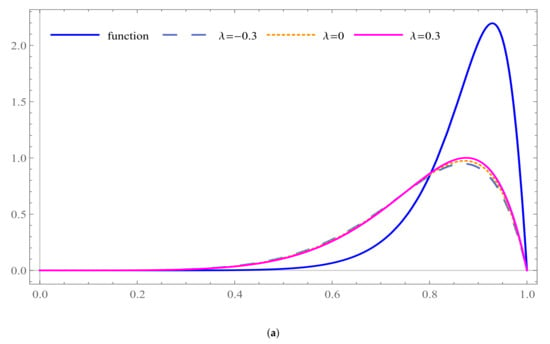
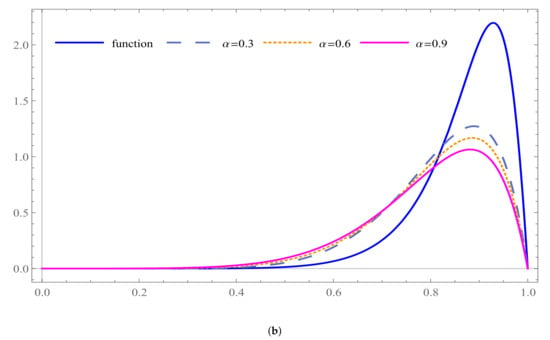
Figure 1.
Approximation and comparison of univariate operators when shape parameters and change. (a) Approximation: . (b) Approximation: .
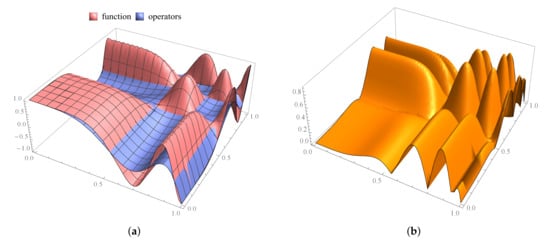

Figure 2.
Approximation and error of approximation of operators when shape parameter changes. (a) Approximation: . (b) Error of approximation: . (c) Approximation: . (d) Error of approximation: .
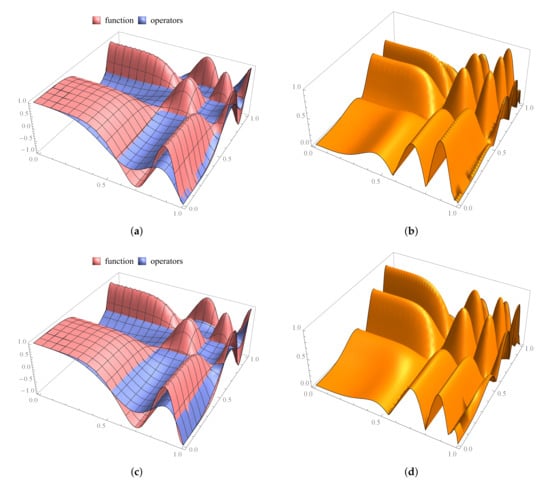
Figure 3.
Approximation and error of approximation of operators when both shape parameters and change. (a) Approximation: . (b) Error of approximation: . (c) Approximation: . (d) Error of approximation: .
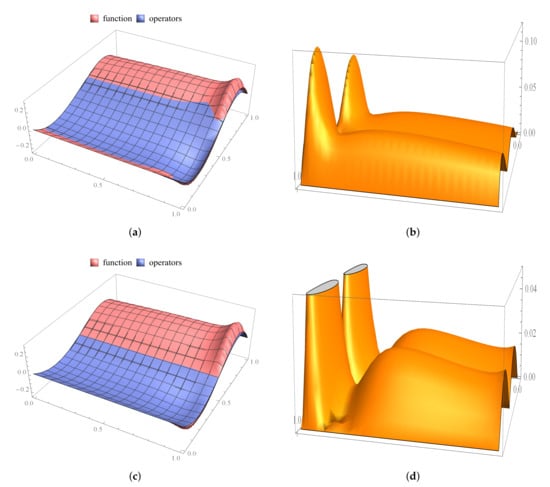
Figure 4.
Approximation and error of approximation of operators when shape parameter changes. (a) Approximation: . (b) Error of approximation: . (c) Approximation: . (d) Error of approximation: .
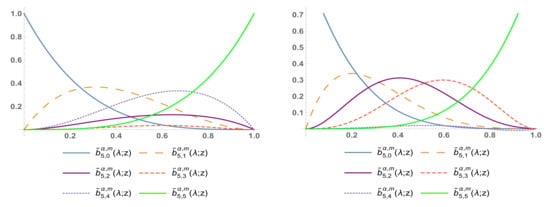
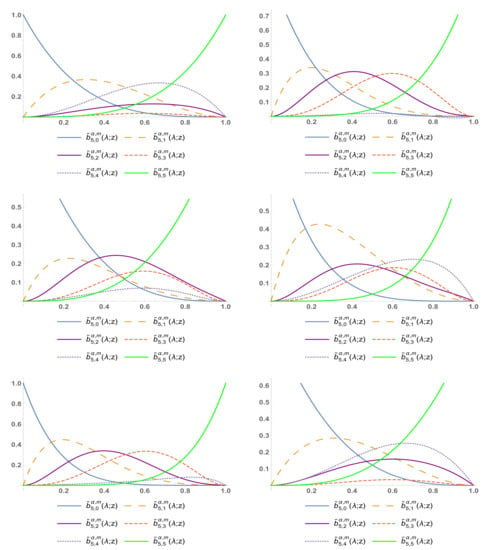
Figure 5.
Approximation of operators when shape parameter changes (s = 3).
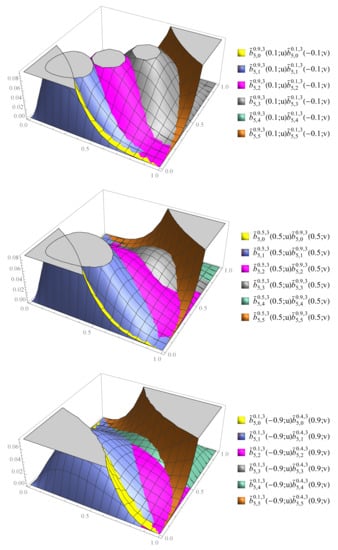
Figure 6.
Approximation of operators when shape parameter changes (s = 3).
Example 1.
We first took the function into account with to show the convergence of univariate operators for different values of α and λ in Figure 1. Furthermore, Figure 1 shows the comparison of blending univariate operators. It is clear that the new blending operators have a better approximation thanks to the shape parameters α and λ.
Example 2.
Example 3.
We finally used the bivariate function:
in Figure 4 to verify the approximation of bivariate operators with and
Author Contributions
Methodology, M.T.E.; Visualization, F.Ö.; Supervision, Q.-B.C. and K.J.A.; Validation, K.J.A.; Writing (original draft), F.Ö.; Writing (review and editing), Q.-B.C., K.J.A., M.T.E. and F.Ö. All authors have read and agreed to the published version of the manuscript.
Funding
The authors (Khursheed J. Ansari and Faruk Özger) extend their appreciation to the Deanship of Scientific Research at King Khalid University for funding this work through the research groups program under Grant Number R.G.P.2/172/42. The authors thank Fujian Provincial Key Laboratory of Data-Intensive Computing, Fujian University Laboratory of Intelligent Computing and Information Processing, and the Fujian Provincial Big Data Research Institute of Intelligent Manufacturing of China.
Informed Consent Statement
Not applicable.
Acknowledgments
The authors (Khursheed J. Ansari and Faruk Özger) extend their appreciation to the Deanship of Scientific Research at King Khalid University for funding this work through the research groups program under Grant Number R.G.P.2/172/42.
Conflicts of Interest
The authors declare no conflict of interest.
References
- Weierstrass, V.K. Ueber die analytische Darstellbarkeit sogennanter willkürlicher Functionen einer reellen Veranderlichep sp. Sitzungsberichte der Akademie zu Berlin. 1885, pp. 633–639 and 789–805. Available online: https://hat.net.technion.ac.il/files/2021/02/wei3.pdf (accessed on 1 February 2022).
- Bernstein, S. Dámonstration du tháorème de weirstrass. Foundeá sur le calcul des probabilitás. Commun. Soc. Math. Kharkow 1912, 13, 1–2. [Google Scholar]
- Usta, F.; Akyiğit, M.; Say, F.; Ansari, K.J. Bernstein operator method for approximate solution of singularly perturbed Volterra integral equations. J. Math. Anal. Appl. 2022, 507, 125828. [Google Scholar] [CrossRef]
- Usta, F. Bernstein approximation technique for numerical solution of Volterra integral equations of the third kind. Comput. Appl. Math. 2021, 40, 161. [Google Scholar] [CrossRef]
- Chen, X.; Tan, J.; Liu, Z.; Xie, J. Approximation of functions by a new family of generalized Bernstein operators. J. Math. Anal. Appl. 2017, 450, 244–261. [Google Scholar] [CrossRef]
- Mohiuddine, S.A.; Özger, F. Approximation of functions by Stancu variant of Bernstein-Kantorovich operators based on shape parameter alpha. Revista de la Real Academia de Ciebcias Exactas y Naturales Serie A Matemáticas 2020, 114, 70. [Google Scholar] [CrossRef]
- Mohiuddine, S.A.; Ahmad, N.; Özger, F.; Alotaibi, A.; Hazarika, B. Approximation by the Parametric Generalization of Baskakov-Kantorovich Operators Linking with Stancu Operators. Iran. J. Sci. Technol. Trans. Sci. 2021, 45, 593–605. [Google Scholar] [CrossRef]
- Özger, F.; Srivastava, H.M.; Mohiuddine, S.A. Approximation of functions by a new class of generalized Bernstein–Schurer operators. Revista de la Real Academia de Ciencias Exactas Físicas y Naturales Serie A Matemáticas 2020, 114, 173. [Google Scholar] [CrossRef]
- Ye, Z.; Long, X.; Zeng, X.M. Adjustment Algorithms for Bézier Curve and Surface. In Proceedings of the 2010 5th International Conference on Computer Science & Education, Hefei, China, 24–27 August 2010. [Google Scholar]
- Cai, Q.B.; Lian, B.-Y.; Zhou, G. Approximation properties of λ-Bernstein operators. J. Inequal. Appl. 2018, 2018, 61. [Google Scholar] [CrossRef]
- Aktuğlu, H.; Gezer, H.; Baytunç, E.; Atamert, M.S. Blending type α-Bernstein operators. submitted.
- Aktuğlu, H.; Yashar, Z.S. Approximation of functions by generalized parametric blending-type Bernstein operators. Iran. J. Sci. Technol. Trans. Sci. 2020, 44, 1495–1504. [Google Scholar] [CrossRef]
- Nasiruzzaman, M.; Rao, N.; Wazir, S.; Kumar, R. Approximation on parametric extension of Baskakov-Durrmeyer operators on weighted spaces. J. Inequal. Appl. 2019, 2019, 103. [Google Scholar] [CrossRef]
- Rao, N.; Nasiruzzaman, M.; Heshamuddin, M. Shadab, M. Approximation properties by modified Baskakov-Durrmeyer operators based on shape parameter α. Iran. J. Sci. Technol. Trans. Sci. 2021, 45, 1457–1465. [Google Scholar] [CrossRef]
- Mohiuddine, S.A.; Kajla, A.; Mursaleen, M.; Alghamdi, M. Blending type approximation by τ-Baskakov-Durrmeyer type hybrid operators. Adv. Differ. Equ. 2020, 2020, 467. [Google Scholar] [CrossRef]
- Rao, N.; Malik, P.; Rani, M. Blending type approximations by Kantorovich variant of α-Baskakov operators. Palest. J. Math. 2020, 9, 1–12. [Google Scholar]
- Sofyalıoğlu, M.; Kanat, K.; Çekim, B. Parametric generalization of the Meyer-König-Zeller operators. Chaos Solitons Fractals 2022, 152, 111417. [Google Scholar] [CrossRef]
- Sofyalıoğlu, M.; Kanat, K.; Çekim, B. Parametric generalization of the modified Bernstein operators. Filomat 2022, 2022, 36. [Google Scholar]
- Özger, F.; Demirci, K.; Yıldız, S. Approximation by Kantorovich variant of λ-Schurer operators and related numerical results. In Topics in Contemporary Mathematical Analysis and Applications; CRC Press: Boca Raton, FL, USA, 2021; pp. 77–94. ISBN 9780367532666. [Google Scholar]
- Özger, F. On new bezier bases with Schurer polnomials and Corresponding results in spproximation theory. Commun. Fac. Sci. Univ. Ank. Ser. A1 Math. Stat. 2020, 69, 376–393. [Google Scholar]
- Rahman, S.; Mursaleen, M.; Acu, A.M. Approximation properties of λ-Bernstein-Kantorovich operators with shifted knots. Math. Methods Appl. Sci. 2019, 42, 4042–4053. [Google Scholar] [CrossRef]
- Özger, F. Weighted statistical approximation properties of univariate and bivariate λ-Kantorovich operators. Filomat 2019, 33, 11. [Google Scholar] [CrossRef]
- Srivastava, H.M.; Özger, F.; Mohiuddine, S.A. Construction of Stancu-type Bernstein operators based on Bézier bases with shape parameter λ. Symmetry 2019, 11, 316. [Google Scholar] [CrossRef] [Green Version]
- Aslan, R. Some approximation results on -Szász-Mirakjan-Kantorovich operators. Fundam. J. Math. Appl. 2021, 4, 150–158. [Google Scholar]
- Cai, Q.B.; Aslan, R. On a New Construction of Generalized q-Bernstein Polynomials Based on Shape Parameter λ. Symmetry 2021, 13, 1919. [Google Scholar] [CrossRef]
- Cai, Q.B.; Aslan, R. Note on a new construction of Kantorovich form q-Bernstein operators related to shape parameter λ. Comput. Model. Eng. Sci. 2021, 129, 1479–1493. [Google Scholar] [CrossRef]
- Rao, N.; Malik, P.; Rani, M. Generalized bivariate Baskakov Durrmeyer operators and associated GBS operators. Fiomat 2022, 36, 1–19. [Google Scholar]
- Mohiuddine, S.A. Approximation by bivariate generalized Bernstein–Schurer operators and associated GBS operators. Adv. Differ. Equ. 2020, 2020, 676. [Google Scholar] [CrossRef]
- Nasiruzzaman, M.; Rao, N.; Kumar, M.; Kumar, R. Approximation on bivariate parametric-extension of Baskakov-Durrmeyer-operators. Filomat 2021, 35, 2783–2800. [Google Scholar] [CrossRef]
- Srivastava, H.M.; Ansari, K.; Özger, F.; Ödemiş Özger, Z. A link between approximation theory and summability methods via four-dimensional infinite matrices. Mathematics 2021, 9, 1895. [Google Scholar] [CrossRef]
- Özger, F. Applications of generalized weighted statistical convergence to approximation theorems for functions of one and two variables. Numer. Funct. Anal. Optim. 2020, 41, 1990–2006. [Google Scholar] [CrossRef]
- Gezer, H.; Aktuğlu, H.; Baytunç, E.; Atamert, M.S. Generalized blending type Bernstein operators based on the shape parameter λ. J. Inequal. Appl. 2022, 2022. [Google Scholar] [CrossRef]
- Kadak, U.; Özger, F. A numerical comparative study of generalized Bernstein-Kantorovich operators. Math. Found. Comput. 2021, 4, 311. [Google Scholar] [CrossRef]
- Özger, F.; Ansari, K.J. Statistical convergence of bivariate generalized Bernstein operators via four-dimensional infinite matrices. Filomat 2022, 36, 507–525. [Google Scholar] [CrossRef]
- Korovkin, P.P. Linear Operators and Approximation Theory; Hindustan Publishing Corporation: Delhi, India, 1960. [Google Scholar]
- Volkov, V.J. On the convergence of linear positive operators in the space of continuous functions of two variables. Doklakad Nauk SSSR 1957, 115, 17–19. (In Russian) [Google Scholar]
Publisher’s Note: MDPI stays neutral with regard to jurisdictional claims in published maps and institutional affiliations. |
© 2022 by the authors. Licensee MDPI, Basel, Switzerland. This article is an open access article distributed under the terms and conditions of the Creative Commons Attribution (CC BY) license (https://creativecommons.org/licenses/by/4.0/).